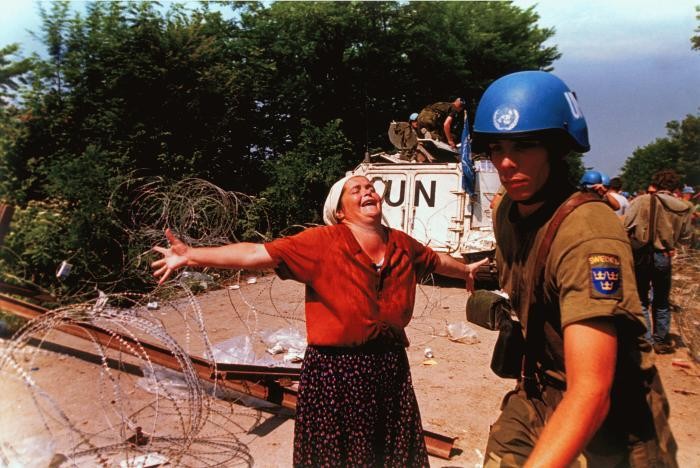
Bosnia
During the conflict in Bosnia from 1992 to 1995, an estimated 100,000 people were killed. Approximately 80 percent of the civilians killed were Bosnian Muslims, known as Bosniaks.
Key Facts
-
1
In July 1995, Bosnian Serb forces killed as many as 8,000 Bosniaks from Srebrenica. It was the largest massacre in Europe since the Holocaust.
-
2
In 2001, the International Criminal Tribunal for the Former Yugoslavia (ICTY) ruled that genocide had occurred in Srebrenica.
-
3
The genocide in Srebrenica continues to challenge us to hold the perpetrators of mass atrocities accountable. Prosecutions continued into 2017.
From 1946 until 1992, Bosnia (formally: Bosnia and Herzegovina) was one of the six republics that comprised the Socialist Federal Republic of Yugoslavia, a multi-ethnic state. In this state, Serbs were the largest minority, followed by Croats and Muslim Bosniaks. Bosnia’s population was 44% Bosniak, 31% Serb, 17% Croat, and 8% Yugoslav.
In the early 1990s, increasing nationalism accompanied by ethnic hostilities and violence led to the breakup of Yugoslavia. Serbian nationalists hoped to create a Greater Serbia by seizing lands from the seceding republics that had Serb populations. The Serbian nationalists created, armed, and trained paramilitary forces to seize territories and drive out their non-Serb populations. In 1991, a war broke out between Serbia and Croatia in which both sides committed atrocities against civilians who were targeted for their ethnicity.
On March 3, 1992, the government of Bosnia declared its independence from Yugoslavia. Bosnian Serbs opposed the creation of an independent Bosnian nation that would have a Bosniak majority. With substantial backing from Serbia, they launched a military campaign that seized two-thirds of Bosnia’s territory and placed the Bosnian capital, Sarajevo, under a brutal siege. The Serbs committed atrocities against Bosniak and Bosnian Croat civilians in areas under their control, killing many and forcing many more to flee in what has become known as "ethnic cleansing." Bosniak and Bosnian Croat forces also committed crimes against civilians based on their ethnicity.

During the subsequent civil war that lasted from 1992 to 1995, an estimated 100,000 people were killed. Approximately 80 percent of the civilians killed during the war were Bosniaks. In July 1995, Bosnian Serb forces killed as many as 8,000 Bosniak men and boys from the town of Srebrenica. It was the largest massacre in Europe since the Holocaust.
On May 25, 1993, while the conflict in Bosnia continued—and a full year before the genocide at Srebrenica—the UN Security Council created the International Criminal Tribunal for the Former Yugoslavia (ICTY) to prosecute the perpetrators of the atrocities. It was the first such tribunal since Nuremberg and the first mandated to prosecute the crime of genocide, among other offenses.
Fighting ended after a NATO bombing campaign forced Bosnian Serbs to the negotiating table, and a peace agreement, the Dayton Accords, was signed in 1995. The agreement established two state “entities” joined by a weak central government: the Serb Republic, which includes Srebrenica, and the Bosnian Federation. Refugees were guaranteed the right to return to their homes, but only a fraction of the prewar Bosniak population has gone back to Srebrenica.
In 2001, the ICTY ruled that genocide had occurred in Srebrenica. Efforts to achieve justice for the victims at Srebrenica are still ongoing in Serbia and internationally. The genocide in Srebrenica continues to challenge us to learn from the past, to hold the perpetrators of mass atrocities accountable, and to prevent these horrific crimes from happening in the future.
Critical Thinking Questions
How can knowledge of the events in Germany and Europe before the Nazis came to power help citizens today respond to threats of genocide and mass atrocity in the world?
How can individuals and leaders recognize and respond to indications that a country is at risk for genocide or mass atrocity?
What factors might serve as precursors to mass atrocity and genocide?
Why are definitions important? Learn more about types of mass atrocities.

